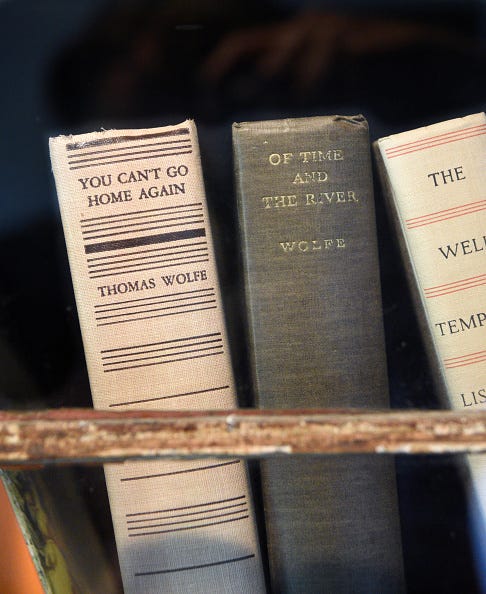The Writer's Almanac from Friday, March 8, 2013
"Snow at the Farm" by Joyce Sutphen, from First Words. © Red Dragonfly Press, 2010.
ORIGINAL TEXT AND AUDIO - 2013
It was on this day in 1935 that Thomas Wolfe's novel Of Time and the River was published. Wolfe's editor was Maxwell Perkins, who also edited Ernest Hemingway and F. Scott Fitzgerald. When Wolfe brought Perkins a draft of Of Time and the River in December of 1933, it was more than one million words long, and still growing. The first installment alone was two feet high.
For a year, Perkins and Wolfe met almost every day, Sunday nights included, to work through the manuscript. During that time, Hemingway invited his editor to join him in Key West, but Perkins declined, writing: "I am engaged in a kind of life and death struggle with Mr. Thomas Wolfe." Wolfe sat beside his desk while Perkins read through every page, red pencil in hand. He slashed many of the pages from corner to corner. Wolfe never gave up arguing with the deletions, and he frequently appeared in Perkins' office with several thousand words of new material which Perkins refused.
Despite the huge cuts, Of Time and the River was still 912 pages long. Wolfe dedicated it to Perkins, and even that was almost 100 words long. The book was a commercial success and received mostly good reviews, but Wolfe was wounded by the negative ones, and became convinced that Perkins had ruined his book. He left Perkins for a new editor. Three years later, dying of tuberculosis at the age of 37, he sent his last letter, apologizing to Perkins and thanking him once again.
It's the birthday of novelist Kenneth Grahame, born in Edinburgh, Scotland (1859). After his mother died, Kenneth and his siblings were sent to live with their grandmother in the village of Cookham Dean in southern England. His grandmother's home, called the Mount, was a rambling old house, with a big attic and garden to play in. He loved exploring the nearby River Thames and the Bisham Woods.
Grahame was an excellent student, and he hoped to go to Oxford, but his once-wealthy family could no longer afford it, and he never went to college. Instead, at the age of 19, he got a job at the Bank of England. He was nostalgic for his childhood, and he used his salary from the bank to collect children's toys — wooden toys and stuffed animals — which filled his flat and surprised unsuspecting guests. He wrote down ideas for stories in his bank ledgers, and published several books, glorifying childhood: The Pagan Papers (1892), The Golden Age (1895), and Dream Days (1898).
When Grahame was 38, still a bachelor, he met 35-year-old Elspeth Thomson. They got married, and had a son named Alistair — he was a weak and sickly child, blind in one eye. He told his son bedtime stories about a character named Mr. Toad and his friends Ratty, Mole, and Badger. Grahame drew on his own happy memories of his sheltered childhood by the River Thames, and he turned the Bisham Woods into the Wild Wood. Eventually, he wrote these stories down and collected them in a book, which he called The Wind in the Willows. It was rejected over and over again, and when it was finally published, it got terrible reviews — critics who loved Grahame's earlier books thought that The Wind in the Willows paled in comparison. But it soon proved to be incredibly popular, in both England and America, and went through four editions in six months.
It's the birthday of writer John McPhee, born in Princeton, New Jersey (1931), a literary journalist known for the huge range of his subjects. He has written about canoes, geology, tennis, nuclear energy, and the Swiss army. He once researched his own family tree and traced it back to a Scotsman who moved to Ohio to become a coalminer.
In high school, McPhee's English teacher required her students to write three compositions a week, each accompanied by a detailed outline, and the students had to read them out loud to the class. Ever since he took that class, McPhee has carefully outlined all his written work, and has read out loud to his wife every sentence he writes before it is published.
McPhee's goal was to write for The New Yorker, but every article he submitted was rejected by the magazine for 14 years. Then, in 1962, McPhee got a phone call from his father about an amazing new college basketball player at Princeton. McPhee went to see him play and decided to write a profile of the young man, whose name was Bill Bradley. That was the first article McPhee published in The New Yorker, and it also became McPhee's first book, A Sense of Where You Are (1965).
McPhee has published more than 25 books, even though he rarely writes more than 500 words a day. He once tried tying himself to a chair to force himself to write more, but it didn't work. He said, "People say to me, 'Oh, you're so prolific.' God, it doesn't feel like it — nothing like it. But, you know, you put an ounce in a bucket each day, you get a quart."
Be well, do good work, and keep in touch.®
A Prairie Home Companion Pretty Good Joke Book
Just when you thought it couldn't get any funnier... This edition of the Pretty Good Joke Book includes all the puns, one-liners, knock-knocks, and knee-slappers of its predecessors, plus dozens more.






The WA you emailed this morning is out of date. John McPhee has published 3 more books since Silk Parachute, the most recent being The Patch in 2018. And the poem feels off. It is about early winter snow and it is March and even in northern New Hampshire we have virtually no snow left. But I enjoyed it never the less. Enjoy the too early spring weather!
Love to read about the lives of writers. Thank you Writers Almanac.